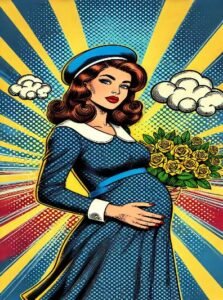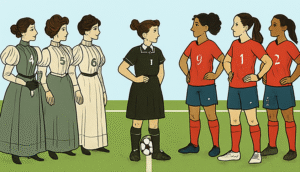Expectant mothers have always wanted to look stylish and gorgeous. However, the fashion industry often forgot about pregnant women or did not understand their wishes. Among the dissatisfied ladies were creative, energetic personalities who resolutely took matters into their own hands, turning fashionable dissatisfaction into exquisite and comfortable outfits.
The Hidden Struggles of Expectant Mothers
A pregnant woman’s life is often a mix of vibrant colors of anticipation and gray shades of physiological and emotional stress. Various limitations, minor troubles, and inconveniences can increase irritation and frustration during this time.
Until the early 20th century, most expectant mothers were confined to their homes for nine months. In the Victorian era, pregnancy was considered something obscene, meant to be kept from prying eyes. Another challenge was the lack of suitable clothing to accommodate a growing belly. Women often had to alter and adapt old clothes, which left them looking far from elegant. And it was the only option for low-income women, as there were no clothes specifically designed for expectant mothers. In addition, the very idea of buying things for a few months seemed merely absurd.
Women with higher incomes who wanted to maintain an active lifestyle faced a similar predicament. Although they had the resources and desire to buy elegant outfits, the fashion market did not provide options. Famous designers of the time, such as Charles F. Worth, did not consider pregnant women as potential clients.
1. The Corsets – A Convenient Solution For Noble Ladies.

In the mid-19th century, the corset became a convenient solution for noble ladies to participate in social life. Advertisers claimed that corsets helped women maintain a slim figure and good physical shape. This new-fashioned piece of clothing was an excellent disguise for a growing belly. It helped not only to fit into a favorite dress but also to maintain, as far as possible, a thin waist that was fashionable at that time. Doctors disapproved of such a desire for grace, as it hurt the developing fetus and often led to miscarriages. But many expectant mothers, wanting to maintain a beautiful figure and appear in society, shackled themselves with corsets even to the detriment of their health. Despite the warnings from physicians, “Gossard Line of Beauty” advertisements claimed their products provided excellent womb support, relieving pressure on abdominal muscles. Moreover, many in high society believed that without such support, a woman could not ensure a healthy birth.
2. The Godmother Of The Maternity Clothing.
The godmother of specialized clothing for pregnant women was dressmaker Lena Himelstein, an immigrant from Lithuania known as Lane Bryant. She became Lane because a bank employee made a mistake in her name when opening a commercial account. At the beginning of the 20th century, she was the first to pay attention to the problem of the lack of pleasant and comfortable clothes for pregnant women.
In 1907, one of Bryant’s regular customers, being pregnant, asked her to sew a decent and comfortable outfit for the outing. A dress with an elastic waistband and a pleated skirt was the first commercial product created for expectant ladies. This innovative clothing has become widely known, making Lane Bryant’s workshop extremely popular among expectant mothers. Middle-class women got an opportunity to have comfortable and elegant clothes that looked great even in the late months of pregnancy.
Rumors about high-quality maternity clothing led to Lane Bryant’s sales reaching $50,000 annually by 1911. And yet, many potential customers remained unaware of Bryant’s outfits. The reason for this was the reluctance of New York newspapers to advertise maternity clothes. The traditions and moral mores of the time did not allow publications to write on such topics. Only in 1911, after long persuasion, Lane Bryant’s company placed an advertisement for its products in the New York Herald newspaper, which had a fantastic effect: the entire stock of clothes was sold out the next day. Later, Lane Bryant created a mail directory for clothing orders so that he no longer depended on the press. Advertising proudly emphasized that all styles of dresses have an adjustable belt. Each outfit could be easily adjusted to a changing figure. Expectant mothers were promised that in such dresses, they would feel all the charm of youth and look great until a child’s birth.
An essential factor in the success of Lane Bryant products was their practicality. All styles were easy to alter and could be worn even after childbirth. Of course, such an economical outfit was a godsend for women with lower incomes who were forced to work even during pregnancy.
3. Page Boy Clothing For An Exquisite Taste.

Years passed, and pregnant women’s tastes became more exquisite. They were no longer satisfied with the mere existence of comfortable clothes. Even being pregnant, they wanted to dress fashionably and look elegant. In addition, there was a significant drawback to the dresses from Lane Bryant—the hem that rises in front as the belly grows.
In 1937, Elsie Frankfurt eliminated such an annoying nuance by adding sophistication and elegance to a maternity outfit. A girl from Dallas, who studied accounting and design at Southern Methodist University, created a stylish suit for expectant mothers. She was prompted to take such a creative step by the despair of her older sister, who was pregnant with her second child. Edna could not wear fashionable outfits, and what was in the stores seemed terrible. In three days, Elsie changed Edna’s old clothes into an exquisite outfit, which was very popular with her sister and acquaintances. The high demand for a maternity suit prompts Edna and Elsie to open their first store. It was conveniently located on the first floor of the building that housed most of Dallas’ obstetrics and gynecology offices. Things went so well that in 1938, sisters Edna, Elsie, and Louise Frankfurt founded a pioneering company called Page Boy to produce clothes for expectant mothers. The very name Page Boy is associated with their logo: a page boy blows a trumpet, notifying everyone of the heir’s birth to the throne.
The highlight of the enterprise was Elsie’s patented design of a skirt with a cutout – a window that fit the hips and did not rise in front with the growth of the belly. Specially removed pieces of tissue that covered the abdomen allowed it to grow freely. The long jacket that came with the set served as a cover for the carved window. As Elsie Frankfurt liked to say, “You can’t hide the fact that you’re expecting a baby, but you can distract from it.” In its advertising, the company assured customers that their skirts do not fit the figure and make women elegant. Thanks to Page Boy, outfits for expectant mothers began to resemble the latest fashionable styles from Paris.
In 1940, Edna rented a shopping window on Wilshire Boulevard to start a second Page Boy boutique. It happened while she was vacationing in Los Angeles. Her impulsive act turned out to be very successful for the family business. On the happy day of the opening, pregnant American actress Margaret Sullavan walked into the store and bought a whole maternity clothing wardrobe. The fateful meeting began a close friendship between the Page Boy company and Hollywood. Among the star clients of the enterprise were Lucille Ball, Judy Garland, Debbie Reynolds, and Grace Kelly. Celebrities also shone on the red carpet in their outfits. Eva Marie Saint, being in the last stages of pregnancy, received an Oscar for her supporting role in the film “On the Waterfront” in a costume from Page Boy. For advertising purposes, the company often used photos of its famous clients. The most famous customer was Jacqueline Kennedy, but this fact was never advertised. The company offered expectant mothers a wide range of products – from ski suits to fur-trimmed evening dresses and underwear. The popularity of Page Boy clothing throughout America was so great that by 1950, it was already available in five stores and three hundred and fifty department stores.
Initially, Page Boy buyers were only among wealthy and professional women. Over time, the company expanded its clientele, appearing in small towns and not forgetting pregnant housewives. An essential factor in the popularity of outfits from Page Boy was their practicality. To extend the life of things, each skirt with a window cutout came complete with a piece of fabric that could be sewn back after the child’s birth.
The loose youth fashion of the 60s put an end to the skirt with a cutout window. The leading trendsetter of the style was not majestic Paris but perky London. A-line dresses looked great on any body type. Without an emphasis on the waist, this style could serve as suitable clothing for expectant mothers. But the Page Boy company would not give up, trying to adapt to new trends. Soon, skirts with elastic waistbands and the then-fashionable short top were developed. Women could wear them after the birth of a child. The company captured the last wave of recognition in the 80s. The Page Boy fashion collection was diverse – from a jacket or bomber jacket to a leather skirt, which first appeared in the assortment for pregnant women.

[ to be continued ]



